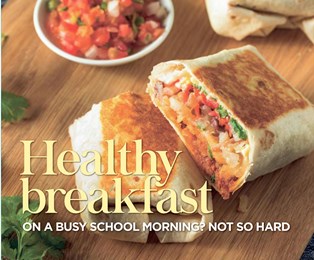Breakfast, as you may have heard, is the most important meal of the day. That’s especially true for kids returning to school, who need fuel for energy and learning.
But serving a healthy breakfast can feel like one more challenge for parents trying to get themselves and their kids out the door on time.
Never fear. With a bit of planning, breakfast can be a great opportunity to get dairy, fiber, fruits and even vegetables into a child’s diet. And it doesn’t have to be complicated.
“It’s not like there’s one perfect breakfast,” says Jessica Jaeger, a registered dietitian at Adelphi University in Garden City, New York. Just try to include a mix of proteins, complex carbs from whole grains and healthy fats. “This helps stabilize blood sugar and appetite,” Jaeger says.
Diane Dembicki, an associate professor of nutrition who works with Jaeger at Adelphi, suggests involving kids in decision-making, and even in prep work the night before.
Avoid the packaged frozen breakfast sandwiches and “breakfast bars” that have names that suggest nutrition but are often high in sugar and fat, Dembicki says.
A few strategies for planning good breakfasts on school mornings:
EGGS CAN BE EASY
Try make-ahead egg cups or breakfast burritos. Kirsten Clodfelter, a mom of three from Louisville, Kentucky, does meal prep on Sundays with the help of her oldest, who is 7. They scramble eggs with a variety of chopped add-ins (sausage with diced onion and peppers, or perhaps bacon and spinach), and then put the eggs in a tortilla with a bit of cold cheese and wrap it in foil (for reheating in the oven the next morning) or plastic wrap (for reheating in the microwave), and freeze it. You can cut the burrito in half for little kids. Choose whole-grain tortillas or flatbread.
Another make-ahead option: Fill the cups of a muffin tin with a mix of egg, veggies and meat, then bake. Once they’ve cooled, pop them out and freeze or refrigerate the individual egg cups. Then quickly microwave them at breakfast time, served with a piece of fresh fruit.
For easy eggs prepared in the morning, Kate Wehr, a mother of four in Montana, suggests combining some chopped veggies and perhaps meat with a well-whisked egg and a bit of butter or olive oil in a ceramic bowl. Cover with a paper towel and microwave for about 45 seconds. The eggs will be ready to scoop into a whole wheat wrap, and breakfast is ready.
If you’re running late, wrap it in wax paper and your child can eat it on the way to school.
GRAINS CAN BE QUICK
Try topping whole-grain toast or a wholegrain waffle with natural nut butter, sliced bananas or other fresh fruit on top, and perhaps a drizzle of honey.
Use natural peanut butter or another natural spread, rather than a brand that’s high in sugar. “I found that starting my kids early with natural peanut butter meant they really didn’t ask for the sweeter stuff,” says Sarah Shemkus, of Gloucester, Massachusetts.
This breakfast hits the macro-nutrient goals of protein, whole grain and healthy fats, and the fruit adds vitamins. A hard-boiled egg made the night before can provide extra protein.
Dembicki also recommends avocado, which has healthy monounsaturated fat and is high in vitamins. Consider a quick avocado toast on whole-grain bread, served with a hard-boiled egg and piece of fruit.
Another whole-grain option: overnight oats made in a Mason jar, or oatmeal set up the night before in a slow-cooker. Let kids choose their ingredients, including fruits and nuts. By flavoring the oatmeal yourself rather than buying pre-flavored, the sugar is kept low.
Shemkus sometimes cooks quick oats in a bowl in her microwave with grated carrot and raisins, then tops it with maple syrup, cinnamon and milk: “We call it ‘carrot cake oat bowl,’ and the 3-year-old loves it.”
COLD BREAKFAST CAN BE COOL
For kids who prefer a cold breakfast, try Greek yogurt with flaxseed, granola and fresh fruit mixed in, and perhaps a bit of honey. Hardboiled eggs also go well with this.
Some families pack an entire breakfast into a blender to create smoothies. Fresh fruit, yogurt or milk, peanut butter and even greens can go in. Clodfelter got her kids to embrace spinach in smoothies by adding it to a berry blend and calling them “Christmas smoothies,” since the green flecks of spinach were combined with red berries.
Or bake healthy muffins in advance. Search for recipes with plenty of fruit or nuts and whole grains. Make a large batch and freeze them. Veggies can be hidden in many muffin recipes, and are front-and-center in recipes like carrotraisin muffins.
And don’t forget dinner for breakfast: Not every kid likes typical American “breakfast foods,” and that’s fine, Dembicki says. If they have favorite dinner meals, make extra and pack leftovers in small containers for easy reheating the next morning.













No Comment